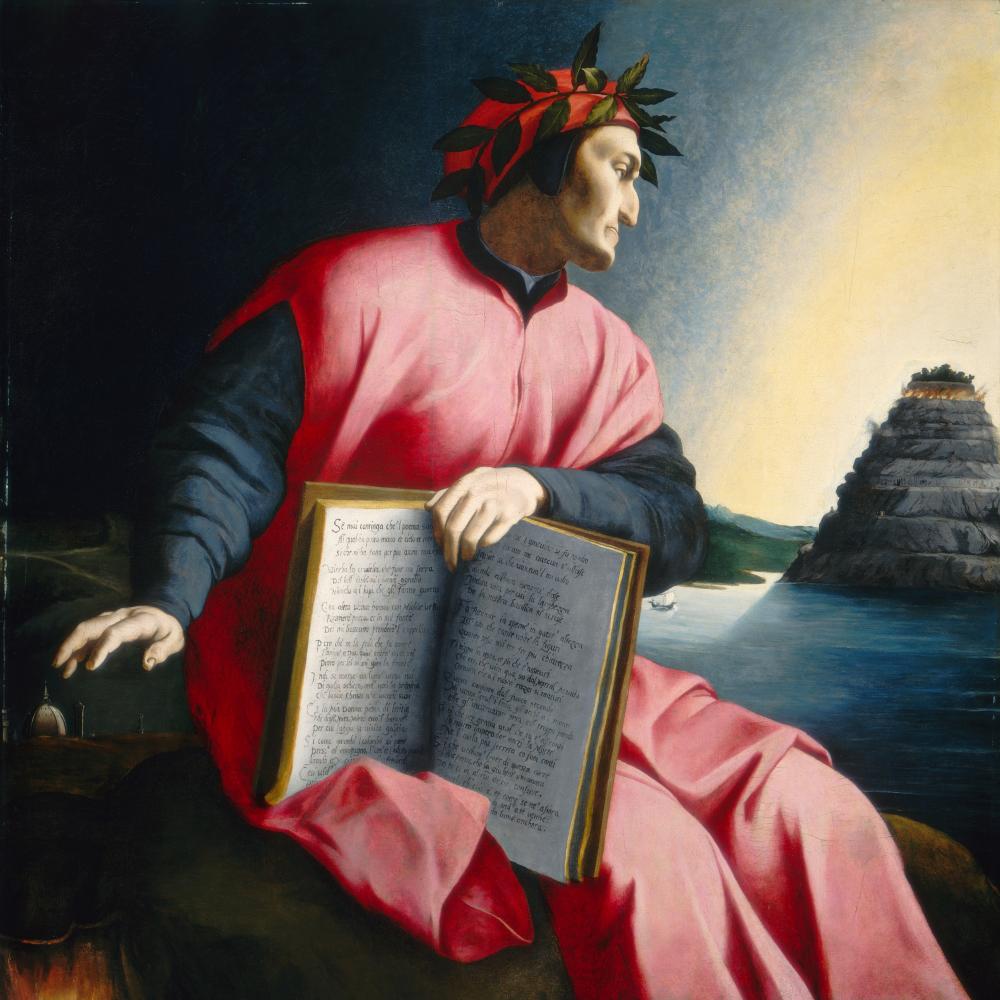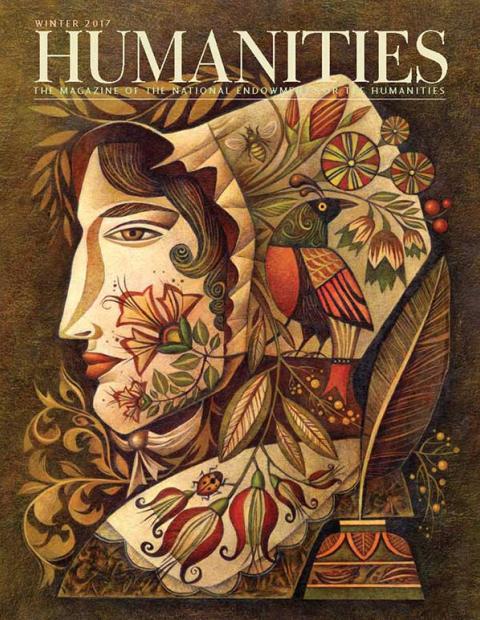The Divine Comedy, finished by Dante Alighieri in 1320, is one of the most famous literary works of all time, and its author is considered the father of the Italian language. In the Inferno, it is well known, Dante singled out corrupt leaders and political enemies, but the poem as a whole was actually inspired by unrequited love.
As a young man, Dante tried to woo a beautiful and devout Florentine girl of his own age. Since childhood they had exchanged in passing the one word their families would allow—Salute! (Health!). Then one day, the young woman, Beatrice, in reaction to rumors of the poet’s increasingly worldly ways, refrained from the greeting, causing anguish in the young Dante. Shortly thereafter, Beatrice died. Dante was transformed by his grief and vowed to write in Beatrice’s honor a poem unlike any ever written. Thus began Dante’s famed journey, one that would take him through the depths of hell. As a one-time admirer of the troubadour poets, Dante was well versed, pardon the pun, in the intricate forms then in practice, such as the sestina, but his paean to Beatrice called for something new and even more demanding, a flexible and muscular form he invented precisely for the new undertaking, the terza rima. Dante wrote his masterpiece on the move, banned from Florence by political enemies. In exile, he paid homage to his true love, Beatrice, and by choosing to write in his Tuscan vernacular instead of Latin, transformed the Italian language.
Having been a bookseller for more than a decade, I know that one of the most frequently asked questions from readers is, Which translation should I read of Dante’s Divine Comedy? It can be overwhelming to see so many versions all lined up, spine to spine, along a shelf in a literary bookstore, or to scroll through pages and pages of different editions online. Talking about a translator’s approach and methodology can help answer the question.
Let’s start a comparison of translations with the first three lines of Canto I of the Inferno (there’s no hiding for the poor translator, with the original Italian usually on the facing page). It may be grossly unfair, I admit, to try to judge merely on the first canto or even the first or second stanza, but decisions made in the first few stanzas determine the shape of the rest of the work. Here’s Dante’s original:
Nel mezzo del cammin de nostra vita,
mi ritrovai per una selva oscura
ché la diritta via era smaritta.
Even without an Italian dictionary at hand, most of the words in these lines can be puzzled out by English speakers, except, perhaps “smaritta,” which means something along the lines of “obliterated” or just “lost from view.” An amateur literal translation can go a long way but doesn’t sing.
In comparing translations, you notice quickly if there’s an attempt to duplicate Dante’s terza rima, in which the first and third lines rhyme, and the second line rhymes with the first line of the following stanza. That interlocking pattern continues throughout the cantos and is one of the work’s most distinctive aspects. Dorothy Sayers rendered the first stanza this way:
Midway this way of life we’re bound upon
I woke to find myself in a dark wood,
Where the right road was wholly lost and gone.
(And “wood” is rhymed with “rude” at the end of the first line of the next stanza, so we know Sayers is attempting to replicate Dante’s rhyme pattern of aba, bcb, cdc, et cetera.)
Allen Mandelbaum’s translation goes like this:
When I had journeyed half of our life’s way,
I found myself within a shadowed forest,
for I had lost the path that does not stray.
Mandelbaum is writing in blank verse (although here the first and third lines rhyme, that is not indicative of the whole), so you’re faced with a choice: Do you trust the efforts, strained at times, of the translator who remains loyal to the form, or opt for a more natural-sounding version?
In comparing these two translations, the Sayers version seems to win out in two ways—it matches Dante in form and, to a degree, in content. By starting with “Midway this way of life we’re bound upon,” she remains faithful to the starting point, “nel mezzo,” while Mandelbaum pushes this to the middle of the first line. Sayers adds “bound upon” (not, strictly speaking, in the original), which allows her to make the rhyme in the third line with “gone.” But Mandelbaum is more faithful to the directness of the original, not stretching the meaning or introducing words to make the rhyme. His metered language often seems more natural than Sayers’ and more in keeping with the diction of Dante, which favored solid vocabulary and straight-forward syntax. Mandelbaum, will, in fact, interject rhyme if it’s not forced (as he does with way and stray). In spite of first impressions favoring Sayers, most readers who choose to make the entire journey from inferno to purgatory and finally paradise ultimately find the Mandelbaum translation more satisfying.
Michael Palma’s 2003 translation of Inferno begins this way:
Midway through the journey of our life, I found
myself in a dark wood, for I had strayed
from the straight pathway to this tangled ground.
His translation keeps the “nel mezzo” element up front and duplicates the terza rima, continuing the next stanza with, “How hard it is to tell of, overlaid . . .”.
This nineteenth-century blank-verse version by Longfellow sounds surprisingly modern:
Midway upon the journey of our life
I found myself within a forest dark,
For the straightforward pathway had been lost.
He remains faithful to the wording, but for reasons of meter he delves into unnatural word order, inverting what Palma has as “dark wood” to become “forest dark.” Palma or Longfellow? A tough call. Again, it might come down to your trust in a translator’s skill in keeping up the rhyme pattern.
Clive James’s 2013 Comedy uses quatrains and augmented quatrains as its building blocks, while Mary Jo Bang’s 2012 translation of the Inferno in colloquial American English, carries elements of her own style, and is unrhymed. Both versions are vibrant and deal adroitly with some enigmatic aspects of the original text.
My preference for a rhyming attempt wins out over Mary Jo Bang’s exuberant rendering, but only by a smidgen. Here are Clive James’s first lines:
At the mid-point of the path through life, I found
Myself lost in a wood so dark, the way
Ahead was blotted out.
These lines have the virtue of being faithful to the original content, and then the next line continues with a rhyme (“The keening sound . . .”) that keeps the pattern going forward, naturally to the ear.
Mary Jo Bang starts out this way:
Stopped mid-motion in the middle
Of what we call our life, I looked up and saw no sky—
Only a dense cage of leaf, tree, and twig. I was lost.
Her creative leap is to begin with the word “stopped” and end the third line with “I was lost,” emphasizing the predicament in the original and elaborating the image of the dark wood. Her methodology comes from picking up a book of poems by Caroline Bergvall and reading “Via (48 Dante Variations),” a “found poem,” she writes, “composed entirely of the first three lines of the Inferno culled from forty-seven translations archived in the British Library as of May 2000). . . . I wondered how else one could say ‘Midway through our life, I found myself in a dark wood; the right way was lost.’”
Both James and Bang are poets. James writes in the introduction to his Comedy, “I wanted the rhyming words close enough together to be noticed.” His devotion to language leads him in one direction, aiming even to end each book of the Comedy with a couplet whose final word is “stars,” as Dante did. “But in English,” he writes, “the word ‘stars’ has very few words with which to rhyme. Rather than write a strained couplet to close each book, I wrote a final line in which the stars indeed show up, but not as the last word.” Bang is led in another direction, hewing to a definition of translation by Walter Benjamin: “A translation, instead of resembling the meaning of the original, must lovingly and in detail incorporate the original’s mode of signification, thus making both the original and the translation recognizable as fragments of a greater language.”
Translator Robert Wechsler observed that “the foreign writer’s work looks like gibberish, or would if we ever saw it. Just like a musical score to someone who can’t read music. But the musician’s performance doesn’t look anything like a score; the two couldn’t be any more different. The translation is so similar, the result is a palimpsest, two works, one on top of the other, an original and a performance, difficult to tell apart.” Seeing translation in this light, may help decide which Dante to read. It may also soften the oft repeated and harsh judgment traduttore, traditore or “translator, traitor.”


